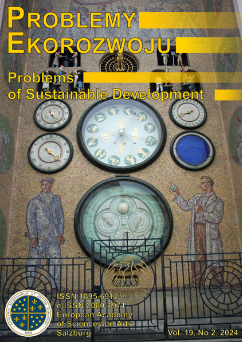Reconstruction of the Urban Historical Centre: Contemporary Problems, Difficulties, and Perspectives
Jawdat Goussous
University of Jordan, Department of Architecture Engineering, Jordan, Amman, 11942, Jordan (Jordan)
Kabila Faris Hmood
Khmood85@gmail.comAl-Zaytoonah University of Jordan, Faculty of Architecture and Design, Department of Architecture (Jordan)
https://orcid.org/0000-0001-8663-8264
Abstract
Adapting historical city buildings into modern facilities is a basic problem in architecture today. In many large cities, historical centers preserve cultural heritage, including spiritual, cultural, economic, and social capital of irreplaceable value. Because of their importance, these centers must consider the unique characteristics of their surroundings, including harmony of size, spatial composition, architectural environment, facades, and the facilities in general. Disharmony in the architectural design of these centers is evident in the non-compliance of new objects, particularly in historical areas of the city. The restoration, reconstruction, and repair of these historical sites require special knowledge. Experts with this special knowledge can implement modern methods, strategic and operational modes of architecture, and public programs to preserve the historical and cultural values of these sites, thus preserving them for the future, which follows the sustainable development concept. The main conclusion of the research is that unique modern buildings, including novel architectural and constructive elements, can coexist with historical ones by using right policies and methods.
Keywords:
architectural reconstruction, historical restoration, cultural values, urban heritage, city centerReferences
AIDAROV S. S., 2003, Architectural regionalism of national republic of Tatarstan: origins and concept of contemporary reflection, Regional and national aspects in architecture: heritage and perspectives, Kazan: 17-41.
Google Scholar
AIDAROV R. S., 2006, Outgoing Kazan: Wooden ensembles of Telman Street, Design and new architecture 22: 56-57.
Google Scholar
AIDAROVA G. N., 2006, Theoretical model of architectural culture of a region, Bulletin of Volga regional branch of RAASN, Nijni Novgorod: 34-39.
Google Scholar
AIDAROVA-VOLKOVA G. N., 1999, Tatar settlements of Kazan: architectural and urban development and methodo-logical aspects of reconstruction, Kazan, KSABA.
Google Scholar
AIDAROVA-VOLKOVA G. N., 2007, Old-Tatar settlement: problem of rescue of architectural heritage and urban devel-opment of the territory, Cultural features of Old-Tatar settlement, Kazan: 8-17.
Google Scholar
APPENDINO FEDERICA, 2017, Balancing Heritage Conservation and Sustainable Development – The Case of Bor-deaux, IOP Conference Series: Materials Science and Engineering 245:062002, https://doi.org/10.1088/1757-899X/245/6/062002.
DOI: https://doi.org/10.1088/1757-899X/245/6/062002
Google Scholar
ASAUL A. N., COSSACKS Y. U., IPATOV V. I., 2005, Reconstruction and restoration of objects of real estate, SPb, Gummanistika.
Google Scholar
BOBROV Y., 1997, The theory of restoration of monuments of art: the laws of contradiction, SPb.
Google Scholar
DONOVAN Р., 2006, Economy of the historical heritage, Ed. CJSC.
Google Scholar
GERASIMOV E. L., 2010, Centres of historical cities. Reconstruction, new construction, https://www.Pandia.ru.htm.
Google Scholar
GOLDSAMT E. A., SHVIDKOVSKY O. A., 1985, Urban culture of European socialistic countries, Moscow, Stroiiz-dat.
Google Scholar
Historic Cities Support Programme, 2004, Conservation and revitalisation of historic Mostar, Aga Khan Trust for Cul-ture: World Monuments Fund.
Google Scholar
HMOOD K., DISLI G., 2019, Sustainable Development of Urban Conserved Heritage, 16th International Conference on Studies, Repairs and Maintenance of Heritage Architecture, STREMAH 2019, 07-09.10.2019, Sevilla, Spain: 13-24.
Google Scholar
KARMAZIN U. I., 2008, Thin line of continuity of generations, Voronezh, VGAS,
Google Scholar
KRASHENINNIKOV A., 2005, The urban development residential development: a study of the experience of the Western countries, Moscow, Architecture.
Google Scholar
KUDRYAVTSEV A. P., 2005, Trust management of cultural and natural heritage in Russia: the precedents, arguments, documents, SIC ICWC Ed., Heritage Centre, Moscow.
Google Scholar
MITYASHIN (KRASNOBAEW) I., 2007, Rescue of Russian estates of Kazan city region: problem and perspectives, Proceedings of the 7th European Conference (SAUVEUR) Safeguarded Cultural Heritage, Understanding & Viability for the Enlarged Europe 2: 1062-1064.
Google Scholar
NORENKOV S. V., 1991, Architectonics of material world, Nijni Novgorod, NNGASU.
Google Scholar
RANINSKY U., 2012, Reconstruction of historical cities: Results of the XX century, Izvestia of Higher Educational Insti-tutions, Architecton, http://archvuz.ru/cont/2074.
Google Scholar
RODWELL D., 2003, Sustainability and the Holistic Approach to the Conservation of Historic Cities, Journal of Architec-tural Conservation 9(1): 58-73.
DOI: https://doi.org/10.1080/13556207.2003.10785335
Google Scholar
THE GETTY CONSERVATION INSTITUTE, 2007, Incentives for the Preservation and Rehabilitation of Historic Homes in the City of Los Angeles, A Guidebook for Homeowners, GCI.
Google Scholar
UNESCO, 1934, Mexico declaration on cultural policy, Cultures: dialogue of world nations, UN.
Google Scholar
UN HABITAT, 2003, Protection and Rehabilitation of the Historical World Heritage, Santiago, Spain, https://www.ucl.ac.uk/dpu-projects/drivers_urb_change/urb_society/pdf_cult_ident/HABITAT_BestPractice_Rehabilitation_Santiago.pdf.
Google Scholar
UN HABITAT,2008, Best practices on social sustainability in historic districts, 2008, SHS, SRP.
Google Scholar
Authors
Jawdat GoussousUniversity of Jordan, Department of Architecture Engineering, Jordan, Amman, 11942, Jordan Jordan
Authors
Kabila Faris HmoodKhmood85@gmail.com
Al-Zaytoonah University of Jordan, Faculty of Architecture and Design, Department of Architecture Jordan
https://orcid.org/0000-0001-8663-8264
Statistics
Abstract views: 339PDF downloads: 276
License

This work is licensed under a Creative Commons Attribution-ShareAlike 4.0 International License.








